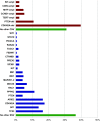Molecular Pathways in Melanomagenesis: What We Learned from Next-Generation Sequencing Approaches
- PMID: 30218391
- PMCID: PMC6153571
- DOI: 10.1007/s11912-018-0733-7
Molecular Pathways in Melanomagenesis: What We Learned from Next-Generation Sequencing Approaches
Abstract
Purpose of review: Conventional clinico-pathological features in melanoma patients should be integrated with new molecular diagnostic, predictive, and prognostic factors coming from the expanding genomic profiles. Cutaneous melanoma (CM), even differing in biological behavior according to sun-exposure levels on the skin areas where it arises, is molecularly heterogeneous. The next-generation sequencing (NGS) approaches are providing data on mutation landscapes in driver genes that may account for distinct pathogenetic mechanisms and pathways. The purpose was to group and classify all somatic driver mutations observed in the main NGS-based studies.
Recent findings: Whole exome and whole genome sequencing approaches have provided data on spectrum and distribution of genetic and genomic alterations as well as allowed to discover new cancer genes underlying CM pathogenesis. After evaluating the mutational status in a cohort of 686 CM cases from the most representative NGS studies, three molecular CM subtypes were proposed: BRAFmut, RASmut, and non-BRAFmut/non-RASmut.
Keywords: Cutaneous melanoma; Genetics; Melanoma subtypes; Mutation status; Next-generation sequencing; Single-nucleotide (SNV) and copy number (CNV) variations; UV signature.
Conflict of interest statement
Conflict of Interest
Giuseppe Palmieri, Maria Colombino, Milena Casula, Antonella Manca, Mario Mandalà, and Antonio Cossu declare they have no conflict of interest.
Human and Animal Rights and Informed Consent
This article does not contain any studies with human or animal subjects performed by any of the authors.
Figures




References
-
- Sacchetto L, Zanetti R, Comber H, Bouchardy C, Brewster DH, Broganelli P, Chirlaque MD, Coza D, Galceran J, Gavin A, Hackl M, Katalinic A, Larønningen S, Louwman MWJ, Morgan E, Robsahm TE, Sanchez MJ, Tryggvadóttir L, Tumino R, Van Eycken E, Vernon S, Zadnik V, Rosso S. Trends in incidence of thick, thin and in situ melanoma in Europe. Eur J Cancer. 2018;92:108–118. - PubMed
-
- Paluncic J, Kovacevic Z, Jansson PJ, Kalinowski D, Merlot AM, Huang ML, Lok HC, Sahni S, Lane DJ, Richardson DR. Roads to melanoma: key pathways and emerging players in melanoma progression and oncogenic signaling. Biochim Biophys Acta. 1863;2016:770–784. - PubMed
Publication types
MeSH terms
Substances
LinkOut - more resources
Full Text Sources
Other Literature Sources
Medical
Research Materials

